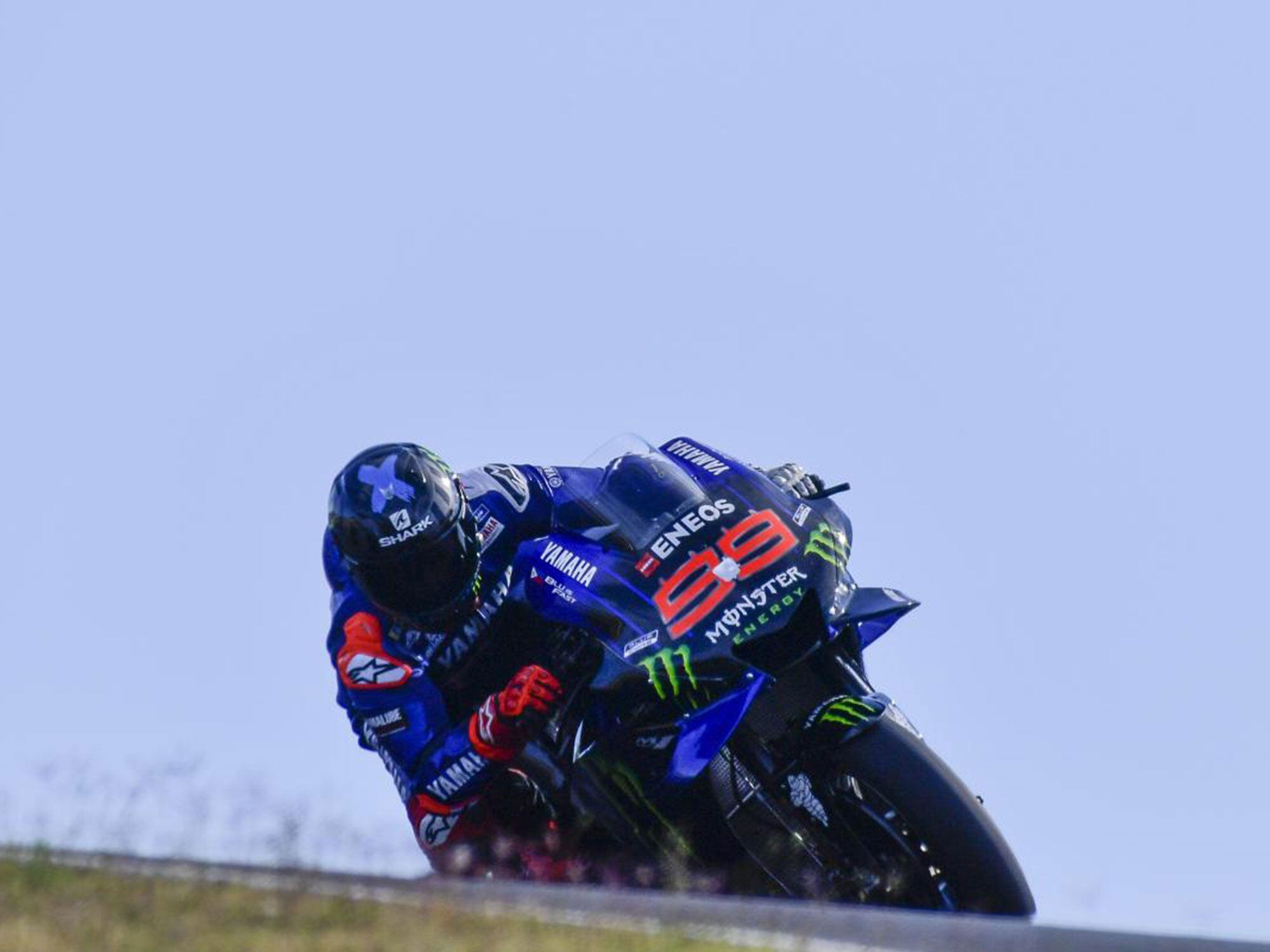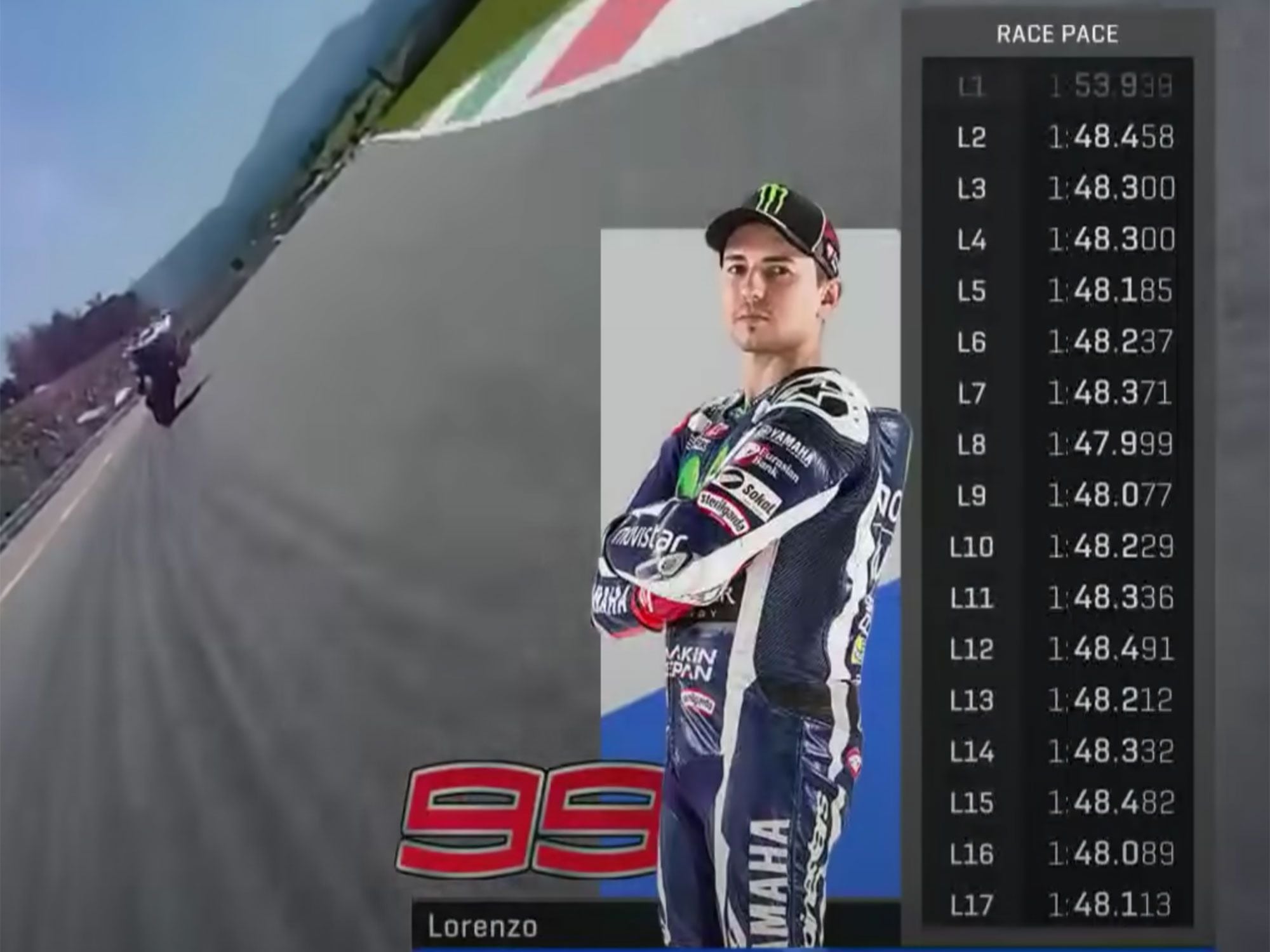
Consistently placing a motorcycle at a desired spot at a precise speed is at the heart of rider safety. Do that on every street ride and you will arrive at destinations while your confidence and skills grow due to consistent rider health. Think “I’m having fun.” Place the bike consistently around the racetrack at track-record speeds and they call you champion. Some riders can run those speeds, some can run consistent laps, but doing both is the secret to glory, cash, titles, and health.
Meet Racers Like Jorge Lorenzo
While following Jorge Lorenzo at the front of the MotoGP field on his Yamaha at the 2016 Australian GP, the MotoGP.com producers posted his lap times, see pic below.

Note that I chose Lorenzo because that was the race I was watching; most championship-winning riders produce lap charts like the Spaniard’s, knocking out laps within tenths of a second of each other all race long. It’s a focus level beyond many people’s imagination, but also a specific process.
How?
How a racer like Lorenzo can run a 2.5-mile track lap after lap with only a few tenths of a second difference between laps is often explained several ways:
- He has memorized the track and knows exactly where to steer into the corner, where to apex, and where to exit.<br/>
- He has run enough laps to know exactly how his bike will feel and react every lap of the race.<br/>
- He has practiced the exact throttle settings, brake pressure, and steering quickness to place the bike perfectly throughout the race.
Those three explanations of consistency are wrong, yet widely believed. Many track riders feel that all they need is “more laps.” Students arrive at YCRS wanting exact points of braking and steering; they want to know when to do what and how much. “Give me the recipe, the silver bullet to speed.”
RELATED: Trail-Braking’s True Purpose
I understand these desires in a sport that is so challenging and risky, but in fact, the consistency of Lorenzo and his ilk has little to do with braking makers or turn-in points or exact throttle percentages at exact places, and all to do with consistent bike direction.
Consistent Direction
The beautiful thing about a champion’s consistency is that we can replicate it on our own rides, at our own speeds. But first, let’s agree on a few things:
- A champion circulates the track as fast as he consistently can.<br/>
- Crashing out of practice, qualifying, or a race is a major fail.<br/>
- The champion’s bike changes lap to lap: losing weight as it burns fuel and losing grip as tires degrade.<br/>
- Each corner on the track challenges the champion to run that corner at the maximum speed their lean angle and track width allow.<br/>
- Corners are usually slower than the adjoining straights.
Are we good with those five points? Nothing earth-shattering, but they lead to why Lorenzo and company knock out consistently fast times all race long: They consistently get their bikes slowed to the maximum speed the corner will allow, at their chosen lean angle.
That, riders, is the secret to consistency: Get your bike to the corner’s slowest point, corner after corner, at a lean angle you are comfortable with. That is the secret to lifelong healthy riding, and if your bike and tires are near their performance limits, but not over those limits, you win a bunch of stuff on the track.
RELATED: Simple And Frequent Trail-Braking Practice
Traverse the corner well below your bike and tire limits and you stay safe. Traverse the corner shockingly above your bike and tire limits and you crash—again remembering that lean angle is factored in as a relatively steady number: what you’re comfortable with or what your bike will allow.
Again: How?
Here is another lap chart from a Lorenzo race:

It isn’t that Lorenzo does exact things at precise moments on the track. It isn’t that his bike is predictably perfect all race. What brings this title-winning consistency is that Lorenzo gets his bike to the speed each corner allows (at his lean angle) corner after corner, lap after lap.
And riders, consistently getting your bike to exact cornering speeds is impossible without trail-braking, or trailing brake pressure into the corners. Lorenzo and gang use their brakes to the slowest point of the corner. They don’t close the throttle and hope deceleration gets them slowed to this exact mph at his exact location, they close the throttle and use the adjustable slowing component, the brakes.
Engine-braking is an inefficient way to slow your motorcycle when compared with engine-braking plus braking. Our bikes decelerate at different rates when at different rpm. They decelerate at different rates uphill versus downhill. More weight onboard means longer deceleration distances. We can’t rely on a slowing device that is un-adjustable and hard to replicate.
If we believe in releasing the brakes at the turn-in (straight-line braking only), we have given up our best speed control well before the slowest part of the corner, and this gets especially tough in blind corners that tighten or have debris to avoid. If Lorenzo tried this, he would be just another unknown racer who crashed themselves out of the sport or slowed down enough to lose the joy of track riding. “Crashes” and “this isn’t much fun” are at the heart of the ex-rider.
No Trail-braking Equals Less Comfort and Consistency
This enormously important statement must be read carefully. It doesn’t say we can’t ride along twisty roads using deceleration or straight-line braking only, but by not braking or by releasing the brakes early, we are “hoping” our speed will be correct for the slowest part of the corner.
When meandering easily along a backroad we are well under the limits of our bike and tires and have plenty of lean angle available to make the corner. The problems come when a surprisingly tight corner presents itself and we are suddenly 25 mph too fast, or when we are enjoying the “motor” in our motorcycle and accelerate a bit too much prior to the corner. Then we add our names to the statistics of “running wide in a corner” because we aren’t doing what Lorenzo does.
Lorenzo learned early that “hope” is a poor racing strategy. He knew that his corner entries would be affected by a wide variety of factors, such as bike placement, fuel load, other riders, going to the brakes too late or too early. What Lorenzo used to cover those variables and mistakes was his ability to modulate trail-braking pressure to arrive at the slowest part of the corner, the direction change, at the precise speed his mind, bike, and tires would allow.
We can ride with Lorenzo-like consistency at our own speeds when we adopt Lorenzo-like trail-braking habits.
More next week!






